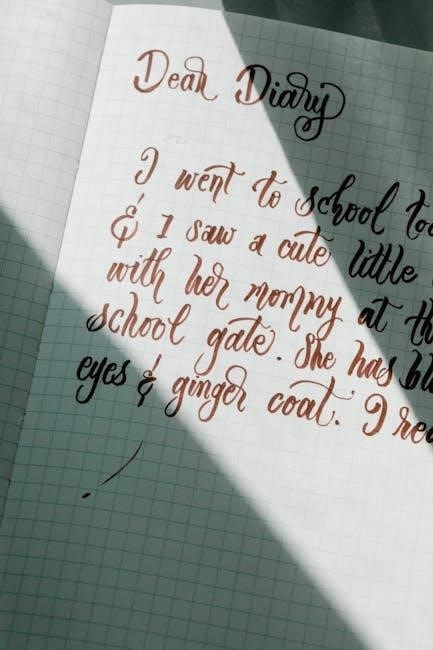The Diary of Anne Frank script PDF captures the emotional depth of Anne’s diary, adapted into a powerful play, offering a poignant glimpse into her life during the Holocaust.
Overview of the Diary and Its Significance
The Diary of Anne Frank is a profound and deeply personal account of a young girl’s experience during the Holocaust. Written while in hiding, the diary captures Anne’s hopes, fears, and resilience as she navigates the challenges of living in secrecy. The diary is not only a historical document but also a universal story of humanity, highlighting themes of hope, survival, and the enduring spirit of youth. Its significance lies in its ability to connect readers to the emotional and psychological realities of life under Nazi occupation, making it a vital resource for understanding this dark period in history.
Brief History of Anne Frank and Her Diary
Anne Frank, a young Jewish girl, began writing her diary in 1942 while living in Amsterdam during World War II. Given to her on her 13th birthday, the diary chronicled her life under Nazi occupation. In 1942, Anne and her family went into hiding in the Secret Annex to evade deportation. There, she documented their daily struggles, hopes, and fears. The diary became a poignant historical record after the war, detailing life in hiding. Tragically, Anne and her family were discovered in 1944 and sent to concentration camps, where Anne died. Her father, Otto Frank, survived and dedicated his life to sharing her diary, ensuring her legacy endures as a testament to the Holocaust’s impact.

Historical Context of the Diary
The Nazi occupation of the Netherlands during WWII led Anne Frank to document her family’s life in hiding, providing a personal and poignant historical record of the Holocaust.
The Nazi Occupation and the Frank Family
The Nazi occupation of the Netherlands during World War II forced Anne Frank and her family into hiding. Fearing persecution, the Franks sought refuge in a secret annex in Amsterdam, where they lived for over two years. This period, documented in Anne’s diary, reveals the daily struggles of living in confinement and the constant fear of discovery.
The diary vividly portrays the family’s resilience and hope amidst the horrors of the Holocaust. Miep Gies, a loyal supporter, provided them with food and news from the outside, highlighting the human kindness that sustained them during this dark time.
Life in the Secret Annex
Life in the secret annex was marked by cramped quarters, shared among eight people, and a constant need for silence. Anne’s diary vividly captures the daily routines, tensions, and moments of hope. The group relied on Miep Gies for supplies and news, while Anne documented their struggles and her personal growth. The annex, though a refuge, was a space of confinement, where every sound risked discovery. Despite these challenges, Anne’s writings reflect the resilience and humanity of those living there, offering a profound insight into their experiences during the Holocaust.
The Significance of Anne Frank’s Diary
Anne Frank’s diary is one of the most important documents of the Holocaust, offering a deeply personal and poignant account of life under Nazi occupation. It captures the hopes, fears, and resilience of a young girl, making the atrocities of the Holocaust relatable through her story. The diary’s universal themes of humanity, hope, and survival have made it a cornerstone of Holocaust education, inspiring countless readers worldwide. Its significance lies not only in its historical value but also in its ability to connect readers with the emotional and psychological experiences of those who lived through one of history’s darkest periods.

Adaptation into a Play
Frances Goodrich and Albert Hackett adapted Anne Frank’s diary into a powerful play, capturing her spirit and the emotional depth of life in hiding during WWII.
The Playwrights and Their Vision
Frances Goodrich and Albert Hackett adapted Anne Frank’s diary into a poignant play, aiming to preserve her spirit and convey the emotional depth of life in hiding. Their vision was to translate the raw honesty and resilience in Anne’s writings into a dramatic format, ensuring her voice resonated with audiences worldwide. By focusing on universal themes like hope and humanity, they crafted a timeless story that continues to educate and inspire. Their work remains a testament to Anne’s legacy, bridging the diary’s personal narrative with the broader historical context of the Holocaust.
From Diary to Stage: The Adaptation Process
The adaptation of Anne Frank’s diary into a play involved transforming her deeply personal writings into a dramatic narrative. Playwrights Frances Goodrich and Albert Hackett carefully preserved the emotional core of the diary while structuring it for the stage. They focused on universal themes like hope, family, and resilience, ensuring the play remained faithful to Anne’s voice. The process required balancing the intimate nature of the diary with the broader historical context, creating a compelling theatrical experience. This adaptation not only honored Anne’s story but also made it accessible to audiences worldwide, emphasizing its educational and emotional significance.
Structure and Key Scenes in the Play
The play is structured to mirror Anne’s diary, with scenes unfolding chronologically. Key moments include the Frank family’s arrival in the Secret Annex, their daily struggles, and the tension among the inhabitants. Dramatic scenes like the arrival of the Van Daans, the conflict over the stolen bread, and the betrayal leading to their discovery highlight the emotional depth. The final scene, where Otto Frank returns to the empty annex, underscores the tragedy. These scenes are crafted to evoke empathy and reflection, ensuring the audience connects deeply with the characters’ experiences and the historical significance of their story.

Characters in the Play
The play features Anne Frank, her family, and the people they hid with, showcasing their complex relationships and resilience during the Holocaust, supported by Miep and others.
Anne Frank: The Protagonist
Anne Frank, the emotional core of the play, is portrayed as a spirited and hopeful teenager. Her diary entries form the foundation of the narrative, offering deep insight into her thoughts, feelings, and relationships. Anne’s character evolves as she navigates the challenges of adolescence in the confines of the secret annex. Her bond with her father, Otto, is particularly poignant, while her interactions with others reveal her growth and resilience. The play captures her optimism, even in the face of immense hardship, as well as her desire to leave a lasting legacy. Her voice remains a powerful symbol of hope and humanity.
Otto Frank: Anne’s Father
Otto Frank, Anne’s father, is portrayed as a kind, supportive, and resilient figure. He serves as the emotional anchor for the family, striving to maintain hope and normalcy in the secret annex. His deep bond with Anne is evident, as he encourages her writing and provides comfort during difficult times. Otto’s strength is tested as he navigates the challenges of hiding, yet he remains a source of wisdom and compassion; His character embodies the struggle to preserve humanity in the face of oppression, while his post-war dedication to Anne’s legacy underscores his enduring love and commitment to her memory.
Edith Frank: Anne’s Mother
Edith Frank, Anne’s mother, is a figure of quiet strength and maternal devotion. Her relationship with Anne is complex, marked by occasional friction but rooted in deep love. Edith struggles to balance her own fears with the need to protect her family, often appearing reserved and worried. Her interactions reveal a woman trying to maintain stability in a chaotic environment, while her care for Anne and Margot underscores her unwavering commitment to their well-being. Edith’s character adds depth to the play, highlighting the challenges of motherhood under extreme circumstances.
Margot Frank: Anne’s Sister
Margot Frank, Anne’s older sister, is portrayed as calm, responsible, and mature. Her reserved nature contrasts with Anne’s vivacity, creating a dynamic sibling relationship. Margot’s quiet strength and obedience often serve as a stabilizing force within the family. While Anne’s diary highlights their occasional rivalry, Margot’s care for her sister is evident. Her role in the play underscores the challenges of growing up in hiding, where her poise and resilience inspire those around her. Margot’s character adds depth to the story, revealing the complexities of family bonds during extraordinary circumstances.
Miep Gies: The Supporter
Miep Gies, a loyal and courageous supporter of the Frank family, played a pivotal role in their survival. She risked her life to provide food, supplies, and emotional support while they were in hiding. Miep’s kindness and dedication were a lifeline for the family, and her visits brought hope and joy, especially to Anne. After the war, Miep retrieved Anne’s diary, ensuring its survival and eventual publication. Her selfless actions and unwavering commitment to the Franks highlight her extraordinary humanity during one of history’s darkest periods. Miep’s legacy endures as a symbol of courage and compassion.
Other Characters in the Play
Beyond the Frank family, the play introduces several other characters who add depth to the story. These include the Van Daan family, with whom the Franks share the secret annex, and Fritz Pfeffer, a dentist who later joins them in hiding. Each character brings their own struggles and personalities, creating tension and camaraderie within the confined space. Additionally, characters like Miep Gies and Jan Gies, who risk their lives to support the group, highlight the bravery of those who aided hiding Jews during the Nazi occupation. These individuals collectively portray the complexities of survival and human resilience.

Themes and Symbols
The play explores themes of hope, resilience, and identity, with symbols like the diary representing Anne’s voice and the annex embodying their confined yet resilient existence.
Hope and Resilience
Anne Frank’s diary and the play adaptation embody hope and resilience amid despair. Anne’s optimism, despite the confinement, reflects her belief in humanity’s goodness. The diary serves as a symbol of hope, capturing her longing for a better future. Even in the darkest moments, Anne’s writings inspire resilience, not just for herself but for those around her. Her words, “In spite of everything, I still believe that people are truly good at heart,” resonate as a powerful testament to the human spirit’s ability to endure and hope, even in the face of unimaginable adversity;
Fear and Survival
The Diary of Anne Frank script vividly portrays the constant fear of discovery and the struggle for survival during the Nazi occupation. The play captures the tension and anxiety of living in hiding, as the characters endure the uncertainty of their fate. Anne’s diary entries reveal the psychological toll of confinement, while the characters’ interactions highlight their daily efforts to remain silent and avoid detection. The script underscores the ever-present fear of betrayal and arrest, juxtaposed with the resilience needed to survive. These themes remind audiences of the harrowing realities faced by those in hiding during World War II.

Jewish Identity and Persecution
The script delves into the profound struggles of Jewish identity and persecution during the Holocaust. Anne’s diary entries reflect her grappling with her Jewish heritage amidst Nazi oppression. The play highlights the forced hiding, the wearing of the yellow Star of David, and the constant threat of discovery. Through Anne’s voice, the script conveys the emotional toll of discrimination and the resilience of maintaining one’s identity in the face of unimaginable adversity. These themes serve as a poignant reminder of the atrocities committed and the enduring strength of the human spirit.
Family Dynamics
The script vividly portrays the complex family dynamics within the Frank household. Anne’s relationship with her parents, Otto and Edith, and her sister Margot, is central to the story. The confined living conditions amplify tensions, yet also reveal deep bonds of love and support. Otto’s paternal guidance, Edith’s emotional struggles, and Margot’s quiet resilience are all explored. The play highlights how the family navigates their relationships amidst the pressures of hiding, showcasing both conflict and unity. These interactions humanize the characters, making their story even more relatable and emotionally impactful for audiences.

Stage Directions and Setting
The script details a claustrophobic attic setting, emphasizing the confined living space of the Secret Annex. Stage directions highlight minimal furniture, dim lighting, and hidden entrances, creating a tense atmosphere.
Description of the Secret Annex
The Secret Annex is depicted as a cramped, dimly lit attic space above Otto Frank’s office. The stage directions describe sparse furniture, hidden entrances, and a view of the outside world through a single window. The annex is divided into small areas for sleeping, eating, and limited movement, emphasizing the claustrophobic conditions.Props like a desk, chairs, and a bookcase are used to recreate the Franks’ makeshift home. The setting reflects the family’s isolation and the constant fear of discovery, with sounds from outside, such as the carillon, adding to the tense atmosphere. Lighting and shadows highlight the confined, hidden life they lead.
Use of Props and Costumes
Props in the play emphasize the Franks’ confined life, with items like a desk, chairs, and a bookcase creating the annex’s sparse atmosphere. Anne’s diary is a central prop, symbolizing her voice and hope. Costumes reflect the family’s Jewish identity, with yellow Stars of David visible on their clothing. Layers of worn attire highlight their isolation and limited resources. Furniture and everyday objects, such as candles and a radio, add authenticity to the setting. These details, along with lighting and shadows, enhance the emotional depth of the characters’ struggles and resilience in their hidden world.
Lighting and Sound Effects
Lighting and sound effects in the play enhance the emotional impact, creating a somber yet intimate atmosphere. Soft, dim lighting reflects the annex’s isolation, while shadows emphasize the characters’ hidden existence. Sound effects, such as footsteps, whispers, and distant sirens, build tension and immerse the audience in the Franks’ precarious reality. Chimes and hymns evoke moments of hope, contrasting with the eerie silence during Nazi searches. These elements work together to evoke the fear, resilience, and humanity portrayed in Anne’s diary, bringing the story vividly to life on stage.

Historical Accuracy in the Play
The play mirrors the real events from Anne’s diary, capturing the emotional depth and struggles of life in the annex, while staying true to historical facts.
Portrayal of Events
The play accurately portrays the challenges faced by Anne Frank and her family, capturing their life in the secret annex with detailed scenes and emotional depth. The adaptation closely follows the diary’s narrative, preserving the authenticity of their experiences. Key moments, such as the arrival of the Van Daans and the tension among the group, are depicted with precision. The script highlights the claustrophobic environment and the emotional struggles of the characters, offering a vivid representation of their daily lives and the broader historical context of the Holocaust.
Comparison with the Diary
The play remains faithful to Anne Frank’s diary, capturing her spirit and the essence of her writings. While the script condenses the diary’s content, it retains key themes and emotional depth. The adaptation ensures that Anne’s voice is preserved, reflecting her hopes, fears, and resilience. However, some diary entries were omitted or simplified to fit the stage format, maintaining the core narrative while adapting it for dramatic presentation. The play’s dialogue and scenes mirror the diary’s introspective tone, making it a powerful tribute to Anne’s story and legacy.
Deviation from the Original
The play deviates from the diary in some aspects, simplifying complex emotions and omitting certain entries for dramatic clarity. While the core themes remain intact, the script condenses Anne’s detailed reflections, focusing on key moments. Some characters and subplots are emphasized or altered for theatrical impact. Additionally, the play includes scenes not present in the diary, such as the arrest, which adds dramatic tension. These deviations ensure the story’s adaptability for the stage while preserving Anne’s profound message and emotional depth, making the play a compelling interpretation of her original work.
Educational Significance
The Diary of Anne Frank script PDF is a vital educational tool, enabling students to engage with the Holocaust’s history through its characters and themes, fostering empathy and reflection.
Teaching the Holocaust Through the Play
The Diary of Anne Frank script PDF is a powerful educational resource for teaching the Holocaust, offering students a deeply personal and emotional connection to history. By adapting Anne’s diary into a play, educators can help students visualize the claustrophobic conditions of the Secret Annex and understand the daily struggles of those in hiding. The script provides a unique lens to explore themes of persecution, hope, and resilience, making the Holocaust more relatable and engaging for young learners. Its vivid dialogue and stage directions also encourage critical thinking and empathy, fostering meaningful discussions about human rights and tolerance.
Using the Script in Classrooms
The Diary of Anne Frank script PDF is an invaluable resource for educators, providing a dramatic adaptation of Anne’s diary that engages students in Holocaust studies. Teachers can assign scenes for reading and analysis, encouraging discussions on themes like hope, fear, and resilience. The script’s vivid dialogue and stage directions help students visualize life in the Secret Annex, fostering empathy and historical understanding; It also supports cross-curricular learning, integrating literature, history, and drama. The PDF format makes it easy to distribute and annotate, allowing for interactive lessons and deeper exploration of the text’s emotional and educational significance.
Learning Activities and Discussions
The Diary of Anne Frank script PDF offers rich material for engaging learning activities. Students can analyze key scenes, exploring themes like hope, fear, and resilience. Discussions can focus on character development, such as Anne’s growth and the dynamics between families in the Secret Annex. Assignments might include writing reflections on Anne’s diary entries or creating modern-day diaries inspired by her voice. Group discussions can delve into moral dilemmas and the historical context of the Holocaust. These activities foster empathy, critical thinking, and a deeper understanding of Anne’s story and its universal relevance.

PDF Version of the Script
The Diary of Anne Frank script is available as a PDF, offering a convenient and accessible format for readers to engage with the powerful story digitally.
Features of the PDF
The PDF version of The Diary of Anne Frank script includes the full text of the play, stage directions, and character dialogues. It is easily accessible online, allowing readers to download or view it on various devices. The digital format preserves the original content while offering zoom and search functionalities for convenience. Additionally, the PDF includes annotations, historical context, and study guides, making it a valuable resource for educational purposes. Its portability and clarity ensure an engaging reading experience, keeping Anne Frank’s legacy alive for future generations. The PDF format enhances readability and accessibility, making it a preferred choice for both students and enthusiasts.
Accessing the PDF
The Diary of Anne Frank script PDF is widely available online, with multiple platforms offering free downloads. Users can access it through educational websites, digital libraries, or direct links from reputable sources. The PDF is compatible with various devices, ensuring easy readability on smartphones, tablets, and computers. Additionally, many versions include interactive features like bookmarks and search functions, enhancing the user experience. To download, simply visit trusted sites like Google Drive or Scribd, where the script is often shared for educational purposes. This convenient access allows readers worldwide to engage with Anne Frank’s story seamlessly.
Benefits of the Digital Format
The digital format of the Diary of Anne Frank script offers enhanced accessibility and convenience. Readers can easily navigate through scenes, highlight text, and annotate digitally. The PDF version preserves the original content while allowing for zooming and adjustable font sizes, improving readability. Digital storage also saves physical space, making it ideal for classrooms and personal libraries. Furthermore, sharing the PDF facilitates collaborative learning and discussions among students and educators. Its universal compatibility ensures that Anne Frank’s story reaches a global audience, fostering a deeper understanding of her experiences and legacy.

Impact and Legacy
The Diary of Anne Frank script PDF has left a profound cultural and educational impact, preserving Anne’s story for global audiences and fostering understanding of the Holocaust’s atrocities.
Reception of the Play
The play adaptation of The Diary of Anne Frank has been met with widespread acclaim for its faithful portrayal of Anne’s story. Audiences and critics alike have praised its emotional depth and historical significance. The script, now available in PDF format, has been widely downloaded and utilized in educational settings, fostering a deeper understanding of the Holocaust. Its ability to convey the humanity and resilience of those in hiding has made it a timeless and impactful work, ensuring Anne Frank’s legacy endures for future generations to learn from and reflect upon;
Cultural and Historical Impact
The Diary of Anne Frank has left an indelible mark on global culture and history. The play adaptation, widely accessed via PDF, has become a cornerstone in Holocaust education, fostering empathy and understanding. Its universal themes of hope, resilience, and humanity resonate across cultures, making it a vital tool for combating prejudice. The script’s digital availability ensures its message reaches modern audiences, preserving Anne’s voice for future generations and cementing her legacy as a symbol of hope amidst tragedy. Its cultural impact continues to inspire dialogue on human rights and tolerance worldwide.
Modern Relevance
The Diary of Anne Frank script PDF remains deeply relevant today, addressing themes of prejudice, intolerance, and human resilience. In a world grappling with discrimination and conflict, Anne’s story serves as a timeless reminder of the importance of empathy and understanding. The play’s digital format ensures its accessibility to modern audiences, particularly students and educators, who use it to explore historical and contemporary issues. Its enduring message of hope continues to inspire global dialogue, making it a vital resource for fostering compassion and combating hatred in the 21st century.
The Diary of Anne Frank script PDF stands as a timeless testament to hope and resilience, ensuring Anne’s legacy endures, educating future generations about humanity’s darkest hours.
Importance of Preserving Anne Frank’s Legacy
Preserving Anne Frank’s legacy through her diary and its adaptations ensures future generations learn from her experiences, fostering empathy and understanding of the Holocaust’s atrocities. The script PDF serves as a vital educational tool, enabling students to connect emotionally with history. By keeping her story alive, we honor her memory and promote tolerance, encouraging a world where such tragedies are never repeated. Anne’s voice remains a powerful reminder of the human spirit’s resilience and the importance of standing against oppression.
Final Thoughts on the Script
The Diary of Anne Frank script PDF is a profound adaptation, transforming her diary into a compelling theatrical experience. It captures the emotional depth of her story, maintaining the authenticity of her voice. The play serves as a poignant reminder of the human cost of war and persecution. By bringing Anne’s experiences to the stage, it ensures her legacy endures, educating audiences about the Holocaust and inspiring reflection on hope, resilience, and the importance of human rights. The script remains a vital tool for fostering empathy and understanding in a contemporary context.
